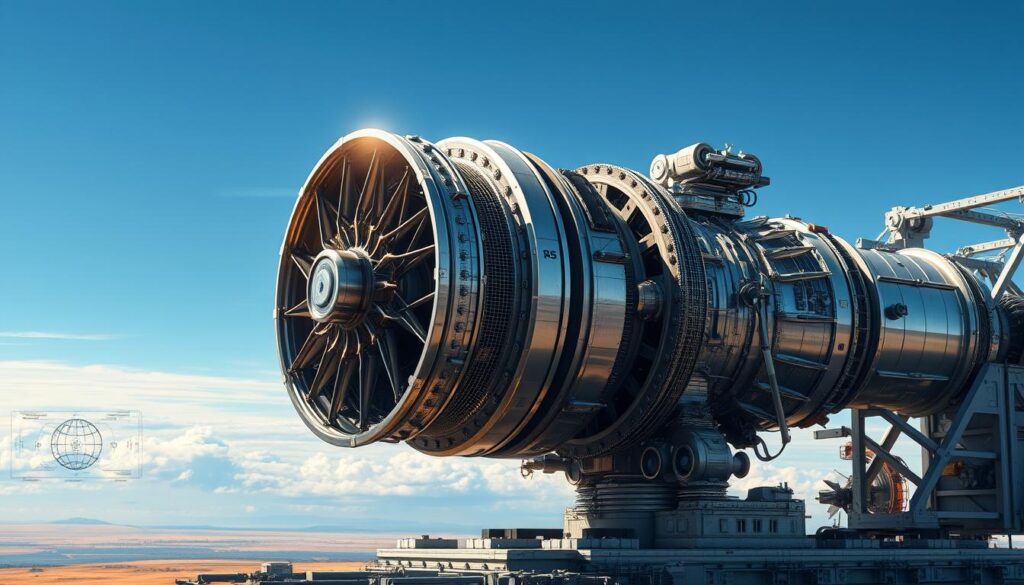“As an Amazon Associate I earn from qualifying purchases.” .
When we look up at the night sky, we feel a sense of wonder. Space’s vastness calls to us, making us want to explore its secrets. At the core of this adventure are rocket propulsion systems. These systems are the quiet heroes of space travel. They help us reach for the stars, pushing our knowledge into the cosmos.
Our space journey shows our creativity. With every launch, we break new ground, driven by a constant need for rocket innovation. From the powerful chemical rockets to the efficient electric ones, these systems are key to our space missions.
The growth of rocket propulsion is amazing. We’ve moved from simple solid-fuel rockets to complex launch vehicles. Now, we’re on the edge of a new space travel era, with new propulsion ideas promising to take us further and faster.
Let’s dive into rocket propulsion systems and see how they make space travel possible. We’ll look at their science, the hurdles they face, and the bright future ahead. Come with us on this exciting space journey, powered by aerospace engineering’s wonders.
Key Takeaways
- Rocket propulsion systems are crucial for space exploration
- Advancements in propulsion technology continue to expand our reach into space
- Chemical and electric propulsion offer different advantages for various missions
- Innovative concepts are shaping the future of space travel
- Understanding propulsion systems is key to appreciating space exploration challenges
The Evolution of Rocket Propulsion
Rocket propulsion history is a journey through time. It started with ancient wooden birds and has led to today’s space-faring vessels. Our quest for the stars has led to big advancements in chemical propulsion and space age technology.
Early Rocket Development
The roots of rocketry go back to 400 B.C. with a steam-powered wooden bird. By 1232, we saw the first true rockets in battle. By the 16th century, rockets were used for dazzling fireworks displays.
Advancements in Chemical Propulsion
In the 20th century, chemical propulsion became key. Robert H. Goddard’s 1926 flight of a liquid-propellant rocket was a major breakthrough. This led to fast growth in rocket technology.
The Dawn of Space Age Propulsion
The space age brought a new era of rocket propulsion. From 1955 to 1965, we made big strides in solid-propellant rocket motors. The Saturn launch vehicle, used in the Apollo missions, showed the best of liquid-propellant engines.
| Time Period | Key Development | Impact |
|---|---|---|
| 400 B.C. | Steam-powered wooden bird | First recorded rocket-like device |
| 1232 | Gunpowder rockets | First true rockets used in battle |
| 1926 | Goddard’s liquid-propellant rocket | Milestone in modern rocketry |
| 1955-1965 | Solid-propellant advancements | Enabled ICBMs and spaceflight |
Today, we keep pushing the limits of rocket propulsion. Our journey from simple fireworks to complex space missions shows humanity’s spirit of exploration and innovation.
Understanding Rocket Propulsion Systems
Rocket propulsion systems are key to space exploration. They use rocket engine mechanics to move forward. These systems work by throwing mass out fast, a principle that applies to all propulsion types.
Rockets come in two main types: liquid and solid. Liquid rockets are heavier but can change their fuel load. Solid rockets are simpler and can wait a long time before starting. Both types use a working fluid to make thrust.

The science behind these systems is amazing. To get to Earth orbit, a rocket must go about 8 kilometers per second fast. That’s 25 times faster than a plane flies. The rocket needs to carry a lot of fuel, at least 20 times the weight of what it’s carrying.
How rockets make thrust is incredible. Chemical rockets can get as hot as 4100 degrees Celsius and go 4300 meters per second fast. Ion thrusters, on the other hand, can shoot ions at speeds up to 60,000 meters per second.
| Propulsion Type | Max Temperature (°C) | Max Speed (m/s) |
|---|---|---|
| Chemical | 4100 | 4300 |
| Ion | N/A | 60,000 |
| Electromagnetic/Plasma | N/A | 75,000 |
As we explore space more, knowing about rocket propulsion is key. From chemical rockets to new tech like nuclear fusion engines, each type is important for our space journey.
Chemical Propulsion: The Workhorse of Space Travel
Chemical propulsion is key to space travel. We’ve seen big leaps in this area, making space exploration possible.
Liquid Propellant Engines
Liquid propellant engines are very powerful and flexible. NASA’s S-IVB stage is a great example. It uses liquid oxygen and hydrogen in one engine for a lot of thrust.
These engines control thrust well, making them great for rocket stages. They can reach speeds of up to 17,000 mph, which is vital for deep space trips.
Solid Propellant Rockets
Solid propellant rockets are simple and reliable. They have a high thrust-to-weight ratio, perfect for the first stages of launch. The Space Shuttle’s solid boosters showed how well they work in sending heavy payloads into orbit.
Hybrid Propulsion Systems
Hybrid propulsion combines solid and liquid tech. It’s simple like solid rockets but has control like liquid engines. The market for these systems is growing fast, expected to reach $293 Billion by 2028.
“Advancements in technology have revolutionized the propulsion systems industry.”
We’ve seen big steps forward in chemical propulsion, from Skylab to the High Energy Astronomy Observatory. These systems are key to exploring space further.
The RS-25 Engine: A Legacy of Power and Efficiency
The RS-25 engine is a symbol of American innovation in space travel. It was first known as the Space Shuttle Main Engine. For over 40 years, it has led our space missions. It powered 135 Space Shuttle missions from 1981 to 2011.

Now, the RS-25 is key to NASA’s Space Launch System (SLS). It can produce over 2 million pounds of thrust. It can also adjust its power from 67% to 109% of its maximum, showing its flexibility and efficiency.
Here are some important facts about the RS-25 engine:
- Each Space Shuttle mission used three RS-25 engines
- It achieved a specific impulse of 452 seconds in vacuum
- The SLS uses four RS-25 engines per launch
- NASA had 16 RS-25 engines from the Shuttle program for SLS
The RS-25’s story continues with the Space Launch System. It powers our next big steps in space. Its power and flexibility are perfect for deep space missions, like the Artemis program to return humans to the Moon.
“The RS-25 engine’s enduring legacy in space exploration underscores its vital role in powering NASA’s ambitious missions and inspiring future generations of engineers and scientists.”
Aerojet Rocketdyne is now working on a new RS-25 engine. This new version will use advanced manufacturing like 3D printing. The goal is to make it cheaper and more efficient. This shows our commitment to improving rocket technology for space travel.
| Specification | Space Shuttle Era | SLS Era |
|---|---|---|
| Power Level | Up to 104.5% | 109% (initial), 111% (later) |
| Number of Engines per Launch | 3 | 4 |
| Total Thrust per Launch | ~1.5 million pounds | Over 2 million pounds |
Nuclear Propulsion: The Next Frontier
The future of space travel is looking bright with nuclear propulsion. This new technology could make visiting distant planets easier than ever. Imagine cutting the trip to Mars from seven months to just two weeks.
Nuclear Thermal Propulsion
Nuclear Thermal Propulsion (NTP) is a big step forward. These engines are much more efficient than traditional rockets. They could make long space trips much faster, opening up new worlds for us to explore.
Nuclear Electric Propulsion
Nuclear Electric Propulsion (NEP) takes efficiency to the next level. It’s perfect for missions that need to save fuel. With this tech, we could go even farther into space than before.
Challenges and Opportunities
Nuclear propulsion is full of promise but also has its challenges. We need to think about safety, design reactors, and follow international rules. But, NASA and the U.S. government are working hard to overcome these issues. They aim to make space nuclear tech a reality in the next 20 years.
| Propulsion Type | Specific Impulse (seconds) | Ideal Use Case |
|---|---|---|
| Chemical Rockets | Up to 460 | Short-duration missions |
| Nuclear Thermal | 850-1000 | Rapid transits, crewed missions |
| Nuclear Electric | 3000+ | Long-term, deep space exploration |
Nuclear propulsion is not just about speed; it’s about expanding our reach in the cosmos and redefining what’s possible in space exploration.
Advanced Propulsion Concepts
We’re on the edge of a new era in space exploration. Future propulsion technologies are leading the way, making space travel faster. Thanks to innovative rocket designs, we’re moving closer to the stars.
NASA’s Marshall Space Flight Center is at the forefront of green propulsion. They’re working on less toxic fuels and testing eco-friendly options. This is a big step towards making space travel sustainable.
Electric propulsion is changing the game for satellites. It’s an affordable way to power spacecraft, showing its potential for future missions. This tech could change how we travel beyond Earth.
“The future of space travel lies in our ability to innovate and create propulsion systems that are both powerful and efficient.”
Nuclear propulsion is also seeing exciting developments. The Nuclear Cryogenic Propulsion Stage project is testing nuclear power for deep space missions. This could be the answer to safely sending humans to Mars and beyond.
- Ion engines
- Plasma propulsion
- Solar sails
- Antimatter drives
These innovative rocket designs are turning into real solutions. They’re making space travel faster and more efficient. As we keep pushing science and engineering, exploring our solar system is within reach.
Thrust Chambers and Nozzle Design
Thrust chambers and nozzle design are key to rocket propulsion. We’ll look into how combustion chambers work, how to make nozzles better, and the materials used for space travel.
Combustion Chamber Dynamics
Combustion in rocket engines is vital for their performance. The speed at which combustion happens, known as the characteristic velocity (C*), depends on temperature and the mix of fuel and oxidizer. The time propellants stay in the chamber, called propellant stay time (ts), is important for mixing and burning well. This time is based on the chamber’s size and how fast the propellants flow in.
The shape of the combustion chamber affects its surface area, weight, and how well it cools. Our space travel calculator takes these things into account when planning trips to space. The way the chamber narrows down affects its size and how well it burns off all the fuel.
Nozzle Optimization Techniques
Designing nozzles is all about making rocket engines work better. A key goal is to increase the specific impulse (Isp), which is about getting exhaust gas out fast. The thrust coefficient (Cf) shows how well the nozzle boosts thrust by expanding the exhaust gases.
Nozzles usually have a cone angle of about 15 degrees for 98% efficiency. The size difference between the narrowest part and the exit is important. A bigger difference means more efficiency and more thrust.
Material Considerations
Materials for thrust chambers and nozzles must handle extreme heat and stress. Tungsten is often used in solid-fuel rockets because it doesn’t melt easily. Graphite is used in the throat area for its ability to handle high temperatures. Carbon fiber is becoming popular for being light yet strong.
Copper and its alloys are great for thrust chambers because they transfer heat well. Cooling systems use steady-state methods to manage the heat. Techniques like fuel film cooling and double-wall designs help with spreading out the heat and keeping the engine running well.
Propellant Composition and Storage
Rocket fuel comes in many forms, each with its own set of properties and storage needs. We’ve seen big steps forward in propellant technology. This has made space exploration more efficient and powerful.
Liquid propellants let us control thrust and restart engines easily. Cryogenic propellants like liquid hydrogen give 30-40% better efficiency than other fuels. The Space Shuttle’s main engines used LOX/LH2, showing how efficient they were.
Storing propellants right is key to mission success. Cryogenic propellants need special tanks to stay super cold. Hypergolic propellants like hydrazine ignite right away, making them perfect for moving spacecraft around.
Let’s explore some common propellant types and what makes them special:
| Propellant Type | Composition | Advantages | Storage Challenges |
|---|---|---|---|
| Cryogenic | LOX/LH2 | High efficiency | Requires extreme cooling |
| Hypergolic | Hydrazine/UDMH | Spontaneous ignition | Toxic, corrosive |
| Solid | Ammonium perchlorate, aluminum | Long-term storage | Non-throttleable |
| Green | LOX/Methane | Non-toxic, high performance | Cryogenic storage needed |
Future missions to Mars might use LOX/methane propellants. They offer better performance and are safe. As we explore space more, new propellant types and storage solutions will be key to our success.
Ignition Systems and Control Mechanisms
Rocket ignition systems have evolved a lot since the early days of space travel. We’ve seen big improvements in how we control thrust and manage engines. These changes have changed how we launch and move through space.
Ignition Techniques
Now, modern rocket engines use advanced ignition methods. For example, the RS-25 engine has a complex system to talk with rocket parts. Some engines need to cool down hours before launch. Others, like the Falcon 9’s Merlin engines, start just seven minutes before they blast off.
Thrust Vector Control
Thrust vector control is key for changing direction in flight. It lets rockets steer mid-flight for precise space travel. This is vital for tricky moves, like landing on other planets.
Engine Throttling
Engine throttling lets us control how much thrust we get. This is crucial for success in tricky tasks like docking with space stations or landing on planets. Being able to adjust thrust helps make space missions more flexible and efficient.
We’ve made big leaps in rocket propulsion technology, from electronic ignition systems to advanced Engine Control Units (ECUs). These advances in engine management are opening up new possibilities for space exploration. They’re helping us reach further into the cosmos.
Performance Optimization and Testing
We’re in an exciting time for rocket propulsion efficiency. At NASA’s Marshall and Stennis Space Centers, we do over 500 rocket engine tests every year. In 2023, we even did 700 tests, with 50,000 seconds of hot fire testing. This hard work helps us improve things like specific impulse and thrust-to-weight ratio.
The space propulsion systems market is growing fast. It went from $8.26 billion in 2022 to $9.66 billion in 2023. This growth means more innovation in making rockets more efficient. We’re using 3D-printed rocket nozzles for deep space missions. These nozzles are lighter, take less time to make, and give more thrust.
Our testing places are getting more popular. Companies like Relativity Space and Rocket Lab are using our facilities. We’re getting ready for more tests with our commercial partners and testing RS-25 engines for the Artemis Program. It’s an exciting time as we work on making rocket designs better for extreme temperatures of 2,500K to 3,000K.
The future of rocket engine testing is looking good. We’re facing challenges like making engines work well at different heights. We’re focusing on nozzle shape, materials, how the propellant flows, and cooling systems. With ongoing testing and improvement, we’re pushing space exploration forward.
FAQ
What are the different types of rocket propulsion systems?
How does the RS-25 engine work?
What are the advantages of nuclear propulsion?
How are rocket nozzles designed for maximum efficiency?
What challenges are faced in propellant storage for space missions?
How do ignition systems and control mechanisms work in rocket engines?
Why is rigorous testing important in rocket propulsion development?
“As an Amazon Associate I earn from qualifying purchases.” .



